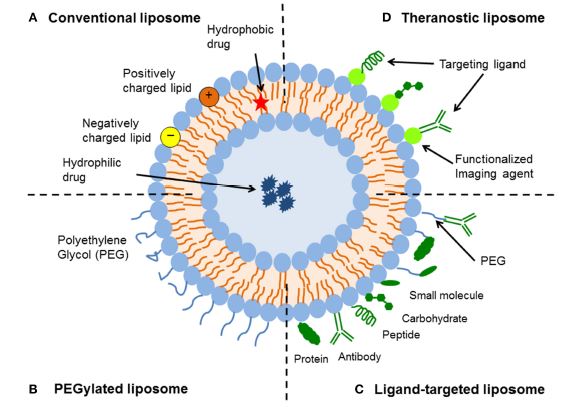What is the Difference Between Amphotericin B and Liposomal Amphotericin B
Table of Contents
The key difference between amphotericin B and liposomal amphotericin B is that amphotericin B is an antifungal medication that contains amphotericin B deoxycholate solution, while liposomal amphotericin B is an antifungal medication that consists of a unilamellar liposomal vesicle made up of a mixture of phosphhatidylcholine, cholesterol, and distearoyl phosphatidylglycerol in aqueous media that contains amphotericin B.
Antifungal medicines are used to treat fungal infections that commonly affect the skin, hair, and nails. The common fungal infections that are treated with antifungal medicines include ringworm, athlete’s foot, fungal nail infection, vaginal thrush, and thrush. Amphotericin B and liposomal amphotericin B are two common antifungal medications. However, some fungal infections such as aspergillosis, which affects the lungs, and fungal meningitis, which affects the brain, need to be treated in hospitals.
CONTENTS
1. Overview and Key Difference
2. What is Amphotericin B
3. What is Liposomal Amphotericin B
4. Similarities – Amphotericin B and Liposomal Amphotericin B
5. Amphotericin B vs Liposomal Amphotericin B in Tabular Form
6. Summary – Amphotericin B vs Liposomal Amphotericin B
What is Amphotericin B?
Amphotericin B is an antifungal medication that contains amphotericin B deoxycholate solution. Amphotericin B is used to treat fungal infections in neutropenic patients, crptococcal meningitis in HIV infection, fungal infection, and leishmaniasis. This original formulation uses sodium deoxycholate, which improves its solubility. Amphotericin B deoxycholate (ABD) is administrated intravenously. As the original formulation of amphotericin B, it is often referred to as conventional amphotericin B.

Figure 01: Amphotericin B
Amphotericin B exerts its antifungal effect by disrupting the synthesis of the cell wall of fungi via binding to the sterols. This leads to the formation of pores in the cell wall, which allow leakage of cellular components. Furthermore, amphotericin B deoxycholate has been the gold standard for the treatment of invasive fungal infections for the past 40 years. Due to the renal toxicity of conventional Amphotericin B, extensive research has led to the development of several new antifungals, including lipid formulations of amphotericin B, board spectrum azoles, and echinocandins.
What is Liposomal Amphotericin B?
Liposomal amphotericin B is an antifungal medication that consists of a unilamellar liposomal vesicle made up of a mixture of phosphhatidylcholine, cholesterol, and distearoyl phosphatidylglycerol in aqueous media that contains amphotericin B. This lipid formulation has been designed in order to improve tolerability and reduce toxicity. Therefore, liposomal formulations have less renal toxicity than amphotericin B deoxycholate. Moreover, liposomal amphotericin B has fewer infusion related reactions. However, liposomal amphotericin B is more expensive than conventional amphotericin B. This antifungal medication can be used to treat systematic fungal infections, cryptococcal meningitis, visceral leishmaniasis, Candida auris fungemia, and histoplasmosis.

Figure 02: Liposomal Amphotericin B
AmBisome (LAMB) is a liposomal formulation of amphotericin B that is normally introduced through injections. Furthermore, it was originally developed by Nexstar Pharmaceuticals and approved by the FDA in 1997. Liposomal amphotericin B is marketed by Gllead in Europe and licensed to Astellas Pharma for marketing in the United States and Sumitomo Pharmaceuticals in Japan.
What are the Similarities Between Amphotericin B and Liposomal Amphotericin B?
- Amphotericin B and liposomal amphotericin B are two common antifungal medications.
- Both antifungal medications contain amphotericin B as the main antifungal agent.
- They are introduced to the patient intravenously.
- Both antifungal medications have the same mechanism: disrupting the synthesis of the cell wall of fungi by binding to the sterols.
What is the Difference Between Amphotericin B and Liposomal Amphotericin B?
Amphotericin B (original) is an antifungal medication that contains amphotericin B deoxycholate solution, while liposomal amphotericin B is an antifungal medication that consists of a unilamellar liposomal vesicle that made up of a mixture of phosphhatidylcholine, cholesterol, and distearoyl phosphatidylglycerol in aqueous media that contains amphotericin B. Thus, this is the key difference between amphotericin B and liposomal amphotericin B. Furthermore, amphotericin B has less tolerability and higher toxicity than liposomal amphotericin B.
The below infographic presents the differences between amphotericin B and liposomal amphotericin B in tabular form for side by side comparison.
Summary – Amphotericin B vs Liposomal Amphotericin B
Amphotericin B and liposomal amphotericin B are two common antifungal medications used to treat fungal infections that normally affect the skin, hair, and nails. Amphotericin B originally contains amphotericin B deoxycholate solution, while liposomal amphotericin B consists of a unilamellar liposomal vesicle made up of a mixture of phosphhatidylcholine, cholesterol, and distearoyl phosphatidylglycerol in aqueous media that contains amphotericin B. So, this is the key difference between amphotericin B and liposomal amphotericin B.
Reference:
1. “Amphotericin B (Conventional) (Amphotericin B Deoxycholate) Dosing, Indications, Interactions, Adverse Effects, and More.” Reference Medscape. 13 Aug. 2021.
2. “Ambisome (Amphotericin B Liposomal) Dosing, Indications, Interactions, Adverse Effects, and More.” Reference Medscape. 21 May 2020.
ncG1vNJzZmivp6x7pbXFn5yrnZ6YsqOx07CcnqZemLyue9ahmK1lmah6tbTEZpuinpaav6a6wp5km52krLKmuoyapKmgn6mys7XCoqVmml2Wu6V5y6KnqKufoq6tecCmp6GnpJq%2Fqq%2FIp2SbZw%3D%3D